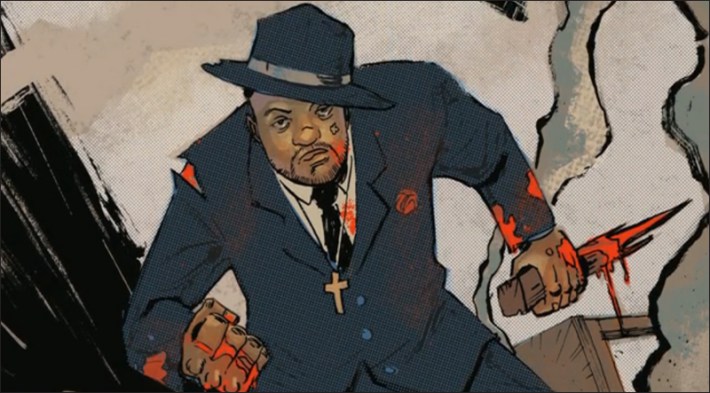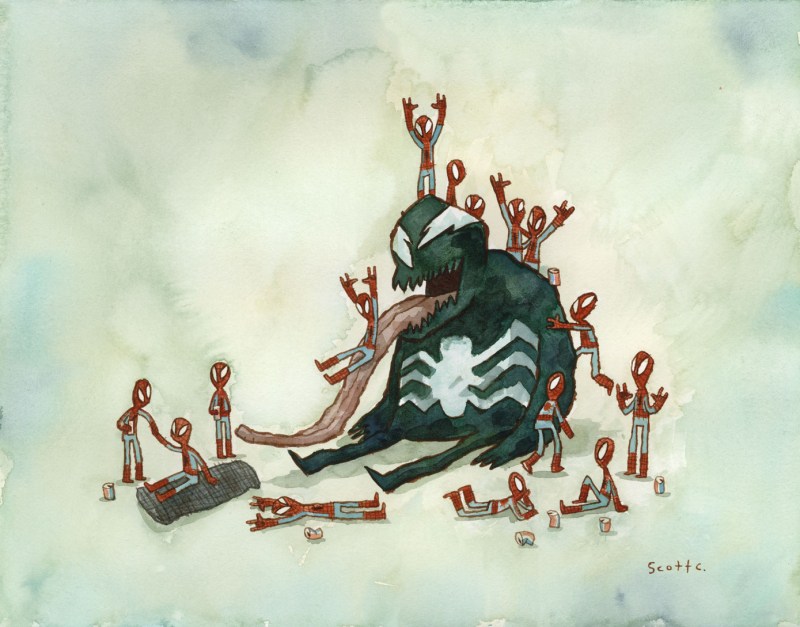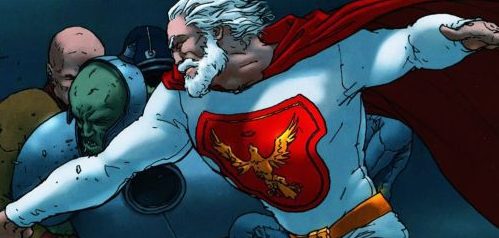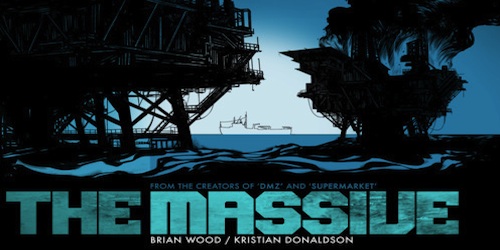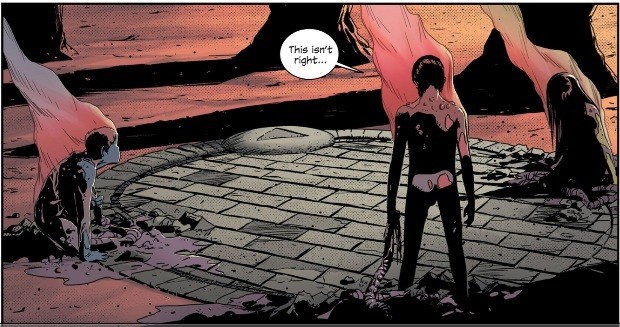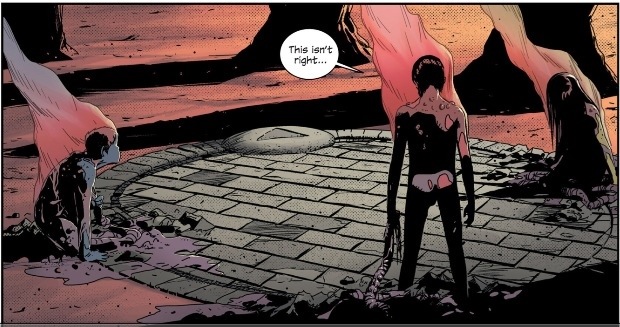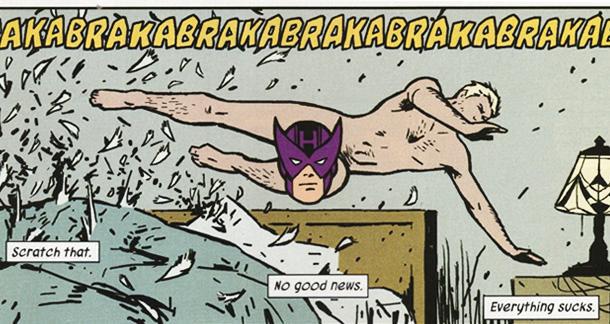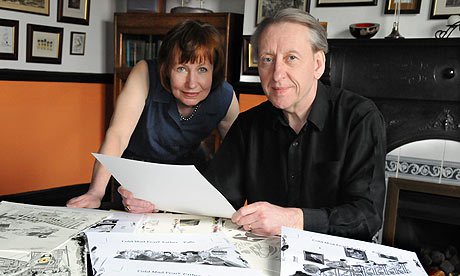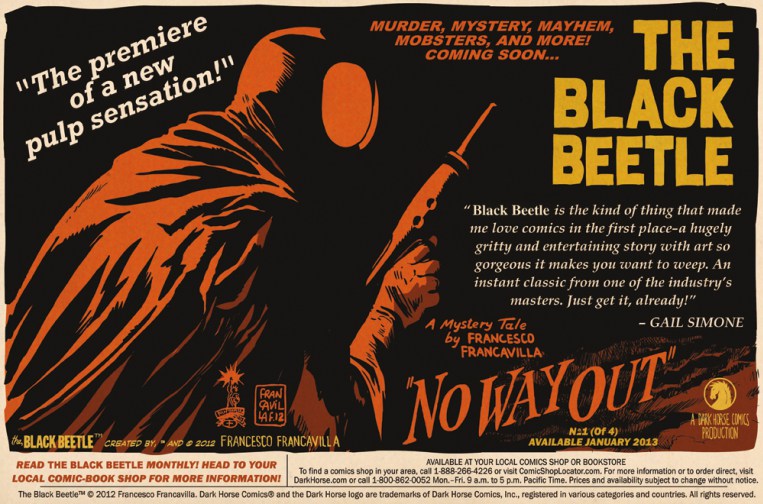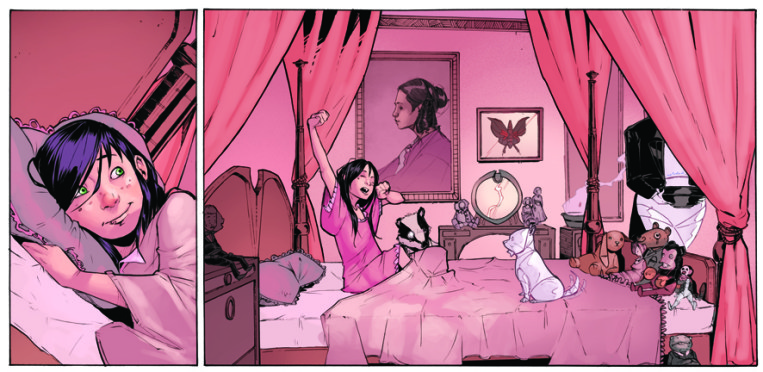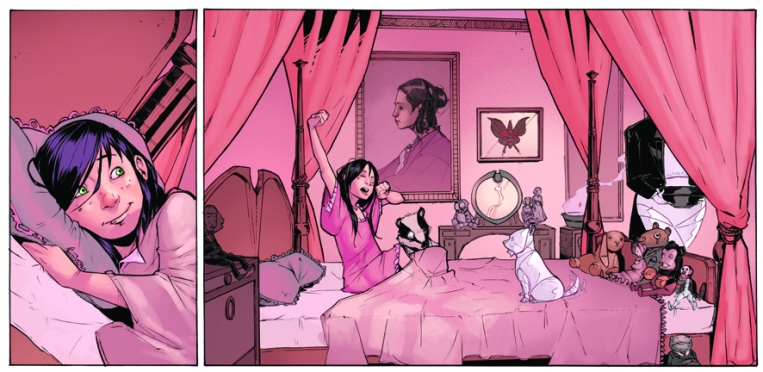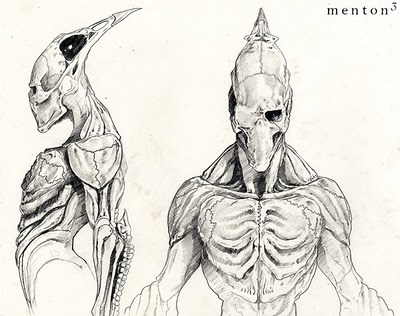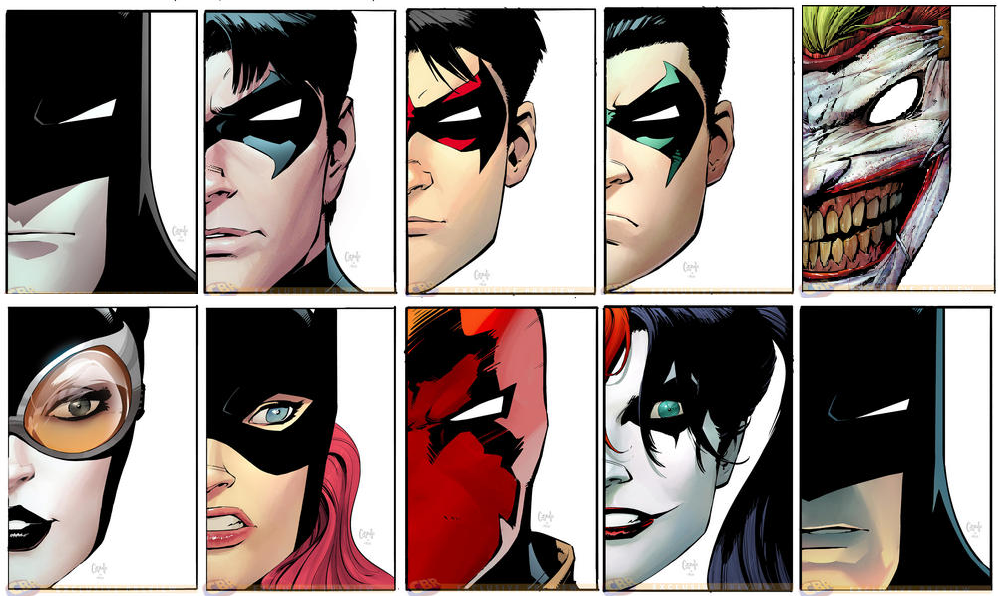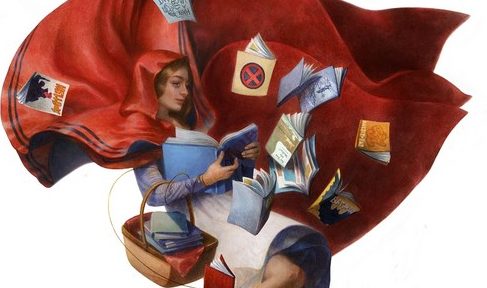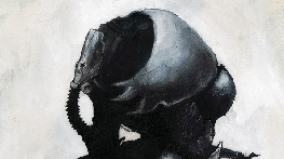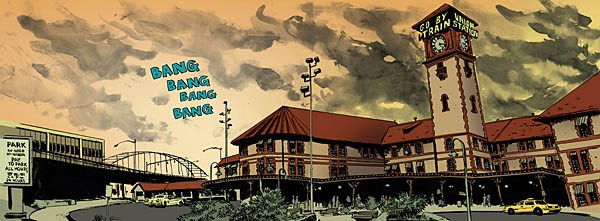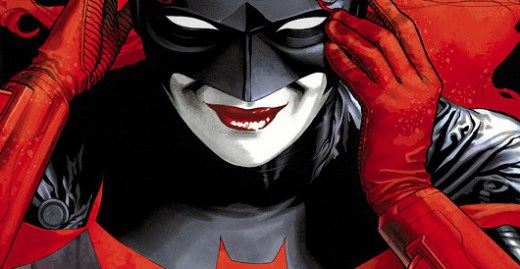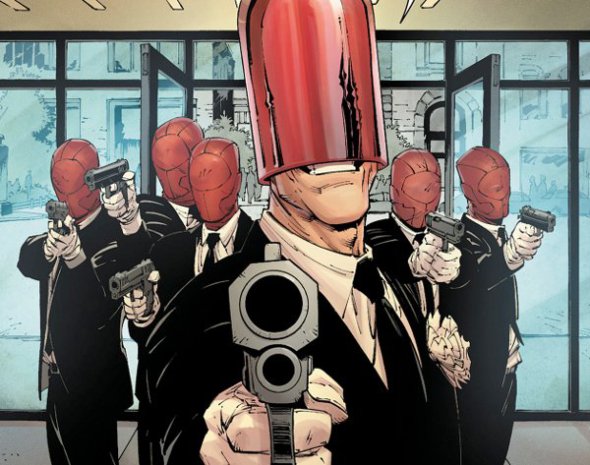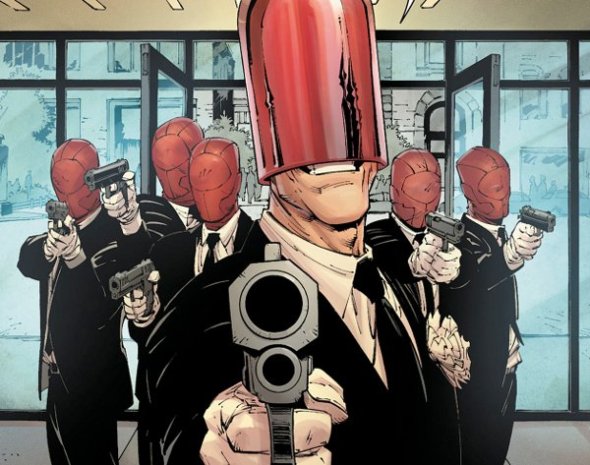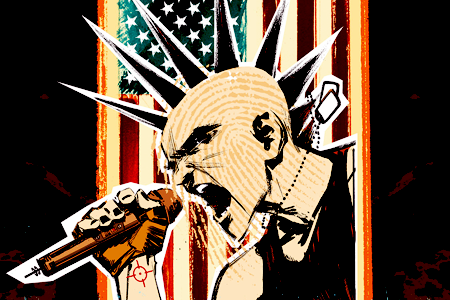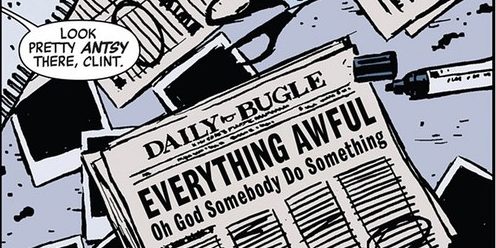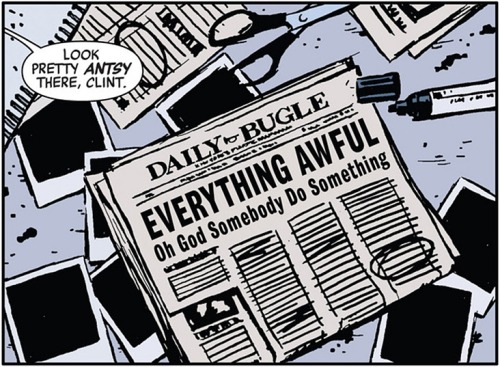Sean Murphy of Batman/Scarecrow: Year One has been given his own six-issue run with a fascinating idea – that DNA extracted from the Shroud of Turin has been used to create a clone of Jesus Christ. An American Idol-style show searched for the Virgin who would give birth to him and found Gwen, an 18-year-old girl who gives birth to the new messiah on national TV on Christmas Day; the introduction panel is touching, to see a young woman full of joy at the sight of her newborn baby despite the cameras and press surrounding her. The child, Chris, is now the main character of a reality TV show called J2, endorsed by a silent Catholic Church and run by the terribly sleazy Rich Slate. Gwen and Chris are protected by an ex-IRA ex-punk bodyguard named Thomas who is on a personal mission of religious redemption by protecting the new Jesus, and a giant friendly polar bear named Cola – I’m not sure how or why but it was almost certainly created by the same biologist who successfully engineered the clone, Dr Sarah Epstein, who has a young girl of her own. The reality show has divided people – some Christians support the show, eager to accept the second coming of Jesus but the New American Christians find it blasphemous and have waged a war on the island where the mother and child are kept. Politicians are worried that Chris may run for President – who could compete with Jesus himself? At the beginning of issue three, Chris is just about to turn five and Thomas is rescuing Gwen from the hoards of fans she encounters anywhere in the outside world.
The first notable thing is the artwork – it’s black and white, which is especially rare in comic books these days, with a dark, heavy edge incredibly reminiscent of old gritty underground comics and the harsh lines of punk – maybe most comparable to Jamie Hewlett’s Tank Girl. The pair escape from manic fans and the NAC on Thomas’ motorbike, all the time being watched by a surveillance helicopter feeding an image straight back to the hideous Jack Slate whose face is always grim and full of lines. A double page header of Gwen and Thomas soaring past on the bike has real manga influences – the background is inky and textured, but in more complex sequences, as when Gwen and Thomas fly off the bike together, the sky is completely clear, only a crescent moon hovering in the plain white. We go straight from the action to Slate lecturing Thomas and Tim, the tech guy, for busting Gwen out of captivity, and it’s easy to hate him already. He’s the kind of guy who pretends to be reasonable and understanding, but is really a snake – he claims that this most recent stunt has made him realise that Gwen cannot leave the Island and that she is now a prisoner. He takes over control of the security and technology sectors and he kisses a terrified-looking Gwen on the head as he reminds her, “Welcome home, Gwen.”
The almost-full page image of the idyllic Island looks amazing – a waterfall crashing over the rocks, a cross as large and iconic as the Rio de Janeiro Jesus figure hovering over the setting sun and extensive wildlife. Gwen and Chris live in a monolithic building looking over it all and they sit high in a window as Gwen reads Chris stories from the Bible and wishes for an angel to save them. Running alongside the stories which Chris already knows are about him, is a TV interview with Nick Slate which gets the reader up to date on the current situation. There is an incredible visual montage of Gwen’s escape attempts as the interviewer lists them and reveals that she has been tagged with a homing device and pumped full of antidepressants. The next thing we’re shown are holographic classrooms designed to teach Chris about the Bible – at first a cutesy images of Jesus standing on water while the villagers cheer him, but then a terrifying apocalyptic image of God’s wrath bent upon the world in the Genesis flood. Dr Epstein removes her daughter Rebekah from the class, but cannot take Chris – separating the children seems incredibly painful for both of them. The interviewer then makes the touchy point that Gwen is slowly fading away from her son. She sits in her room and cries, watched even then by a camera, as Epstein tells the children about her plans to stop global warming – poor Chris is terrified, thinking that the oceans are rising because God has sent another flood. The image of his huge, scared eyes on the inky black background gives such an impression of this scared young boy who is only just learning what it means to be a saviour.
Unfortunately, the conflict of religion and science in Chris’ world leads him to believe he’s capable of walking on water. He isn’t. When Gwen finds out about her son’s brush with death, she storms into Slate’s office screaming. In the background we can see feeds of many news shows already discussing the failed miracle attempt and as Slate threatens Gwen she opens the door to the cameras and stabs herself through the hand with a letter opener. This act of violence is so sudden, and he catches her as she loses consciousness, holding her swoon in an almost romantic way as he promises to let Chris go to public school, in return for her good behaviour.
Exactly half way through the issue, we flash again to a news room. Nine years have passed and Chris has struggled to make friends in public school with his bodyguard always by his side. One fantastic panel shows Chris using a urinal behind Thomas, the other boys too scared to go near. The NAC have been training their members for a “Jesus army” and have an armed patrol outside Chris’ school. A racial controversy has been sparked by rumours that Chris had asked an African-American girl to their prom, and Slate had paid her father to keep her from going, buying the caucasian head cheerleader instead for a date. Chris is pressured to lie and protect Slate, which drives Gwen wild – when they return from the studio she makes another escape attempt with her son, shooting Slate in the process, but instead she is thrown out and separated from her son. Chris is full of rage and it’s here we see the first glimpses of the punk king he’s going to become; smashing windows, spray painting “I’m a hostage” on the side of the building, screaming at the cameras. The last section of the issue shows Gwen stepping out onto the balcony of the Behavioural Health Centre she’s living in, shutting her eyes and letting herself fall from the building to her death. As she falls she is caught by a huge, cybernetic angle who pins her down, screaming at her for her poor parenting. She wakes up, looks in the mirror and sees strange markings on her body. The whole final sequence is full of manga influences from Gwen’s huge, scared eyes to the incredibly striking cyberpunk angel.
The religious elements of the series are incredibly interesting, perhaps most notably in the naming of the characters – all of them have specific meanings and religious connotations. For example, Gwen means to be white, fair or pure – perfect for a virgin mother; Richard (as in Rick Slate) means a powerful leader. Chris is not only similar in sound to Christ, but also means “the one who bears Christ in his soul” and Sarah and Rebekah both have Biblical names; Sarah was the barren wife of Abraham who was given the miracle of a child (appropriate as previous to her having Rebekah, Sarah Epstein was considered infertile) and Rebekah was her daughter-in-law. But the series inverts religion – one of the themes which seems to be evolving is the idea of the second Jesus becoming an atheist. Sean Murphy himself was raised Christian, and when he began the series five years ago he would have described himself as a “militant atheist” – he has calmed over the years and has begun to take a more balanced view of religion, but the elements of questioning God are prevalent throughout. The choice of the punk medium is an excellent way for Murphy to show Chris’ anger at the society which gave him life just to control him – his progression into a mohawked adult is something I can’t wait to see.
The story is incredibly interesting, especially if you have a penchant for Christian and/or punk iconography. The way the characters interact is understandable and so so human; none are perfect but are all struggling to remain sane in the middle of what is not just a religious matter but also one of scientific progression and the moral minefield of cloning human beings. The artwork is beautiful, heavy, adorable and startlingly violent throughout, with whimsical comic book sound effects – my favourite is “Catch!” as Gwen falls into Thomas’ arms. Some readers may be put off by the lack of colour, but Murphy simply doesn’t need it; the expressions on their faces are so emotive and his use of shading and texture creates striking effects on the characters and scenery.
Issue #4 will deal with Chris researching the world he has been kept from, and beginning to effectively rebel with inspiration from Thomas’ old punk collection – not long now till we see the Punk Rock Jesus in full form. Out in December, this is a must-read for fans of underground comics, punk culture and religious imagery.

Written by Jenny Mugridge, lover of all the above.


